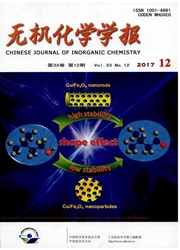

 中文摘要:
中文摘要:
采用自旋密度泛函理论的第一性原理方法并结合晶体配位场理论,研究了Ni离子掺杂锐钛矿相TiO_2体系(NixTi1-xO2;NixTiO_2)的几何结构、缺陷形成能、电子结构以及磁性特征等问题。结果表明:实验上发现的有关Ni掺杂TiO_2体系的很多矛盾,如:晶粒体积的增减、掺杂Ni离子的不同价态、吸收光谱带边移动方向和体系磁性特征的差异等问题都可归因于Ni离子掺杂类型的不同(NiTi;Niin)。分析表明,不同的Ni离子掺杂类型导致所成Ni-O键的键长和电荷布居不同,从而使Ni离子呈现不同的价态,这也是体系宏观电学和磁学性能差异的根本原因。形成能计算表明,通过控制Ni-TiO_2晶体生长过程中的氧环境,可以人为的控制Ni离子的掺杂类型。
 英文摘要:
英文摘要:
The geometric structures, formation energies, electronic structures and magnetic properties of Ni-doped anatase, with different concentrations and doping methods, were studied by the first principle method under the framework of the spin density functional theory, combined with the crystal field theory. The results of formation energy calculation show that the oxygen environment, in the process of crystal growth, has an important influence on the structures of Ni-doping. Analysis of the state density and energy level track map showed that the valence states of Ni ion was different in different doping conditions. Impurity energy levels in the bandgap of all kinds of doping system are formed by the hybridization of Ni3d-O2p. When a doping Ni ion substitute lattice Ti, that will make the unit cell volume and the crystal stability decrease, absorption spectrum red shift, the system is paramagnetic. Interstitial Ni doping makes the unit cell volume increase, the absorption spectrum blue shift, and enables the band to move in the direction of low energy. At this time, the carrier occur n type-degeneration, theability, of some Ti ions, of losing electrons declined, resulting in the making of Ti3 + ions, the system has magnetism.
 同期刊论文项目
同期刊论文项目
 同项目期刊论文
同项目期刊论文
 期刊信息
期刊信息
